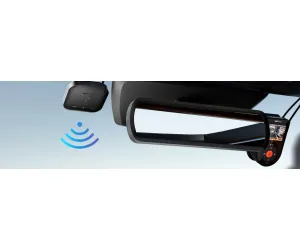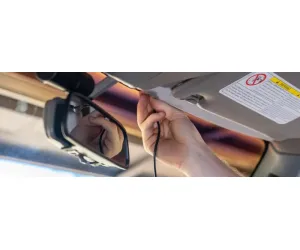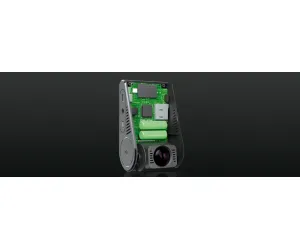
Integrating AI-powered dash cams into your fleet is a significant step toward improving safety and operational efficiency. However, getting drivers to accept this new technology can be a challenge. Many drivers worry about privacy, increased monitoring, and changes in their work environment. Addressing these concerns effectively is essential for a successful rollout.
Here’s a structured approach to introducing AI dash cams in a way that fosters understanding, trust, and cooperation.
1. Clearly Define the Purpose of AI Dash Cams
One of the first questions drivers ask is, “Why do we need dash cams?” The answer is simple: to enhance road safety. AI dash cams monitor potential hazards, detect risky driving behaviors, and provide real-time alerts to prevent accidents. They help identify:
- Drowsiness behind the wheel
- Distractions while driving
- Potential collisions
- Following too closely
- Unsafe lane changes
Beyond preventing accidents, these cameras promote responsible driving habits and offer valuable insights that benefit both drivers and fleet managers. The results speak for themselves:
- 57% of fleet managers report improved driver visibility
- 54% see a reduction in risky driving behaviors
- 45% note increased insurance savings
- 43% experience fewer accidents
AI dash cams aren’t about micromanaging—they’re about making roads safer, protecting drivers, and reducing liability risks.
2. Promote Transparency and Open Communication
Building trust is crucial when introducing AI dash cams. It’s important to clarify how the technology functions. For instance, Motive’s AI dash cam only records and uploads footage when it detects high-risk behavior, ensuring that drivers are not constantly monitored.
Key strategies to establish trust:
- Be upfront about how dash cams work and how they support drivers.
- Acknowledge driver concerns and address them with clear, honest information.
- Use simple, relatable language to explain the benefits without overwhelming technical jargon.
When drivers feel informed and reassured, they are more likely to embrace the technology.
3. Share Real-Life Examples of Dash Cam Benefits
AI dash cams have proven invaluable in protecting drivers from false claims and expensive legal battles. Here are real-world examples of how they help:
- Clearing a driver of fault: A truck driver was accused of rear-ending another vehicle at a stop sign. However, dash cam footage revealed that the other driver had actually reversed into the truck, preventing the truck driver from being wrongfully blamed.
- Defending against false lane-change accusations: A driver was accused of swerving into another lane, but AI dash cam footage proved the other vehicle was at fault, saving the company from potential legal costs.
By demonstrating how AI dash cams provide an unbiased record of events, drivers can see them as an asset rather than a threat.
4. Roll Out AI Dash Cams in Phases
A gradual implementation can make adoption smoother. Instead of installing dash cams across the entire fleet at once, start with a small group of experienced drivers who can serve as advocates for the technology.
Steps for a successful phased rollout:
- Select respected drivers who have strong safety records and influence within the team.
- Engage them in discussions early and provide hands-on training.
- Encourage them to share their experiences once they see the benefits firsthand.
When drivers hear positive feedback from their peers, they are more likely to accept and adopt the technology.
5. Emphasize Coaching Over Discipline
Drivers should view AI dash cams as a tool for improvement rather than punishment. A coaching-first approach helps build trust and encourages positive behavior changes.
Best practices for coaching:
- Recognize and reward safe driving. Highlight examples of good driving behavior in meetings or through incentives.
- Monitor performance over time. Use tools like Motive Safety Scores to track and celebrate improvements.
- Provide structured feedback. Constructive coaching helps drivers enhance their skills rather than fear disciplinary action.
Focusing on growth and safety creates a positive work culture where drivers feel supported rather than scrutinized.
6. Foster a Safety-First Culture Across the Team
For AI dash cams to be effective, fleet-wide engagement is necessary. Getting buy-in at all levels—from drivers to management—ensures a successful integration.
How to build team-wide acceptance:
- Address concerns at every level through open discussions and transparent communication.
- Integrate AI dash cams into existing safety programs to align with company values.
- Track progress and set goals using tools like Motive Safety Scores to measure improvements in driving behavior and accident reduction.
- Encourage continuous learning and adaptation by regularly reviewing feedback and refining safety initiatives.
From Resistance to Results: A Smarter Approach
When introduced thoughtfully, AI dash cams can transform fleet safety, protect drivers, and improve operational efficiency. Prioritizing open communication, phased adoption, and a coaching-focused strategy ensures smooth integration and long-term success.
By addressing concerns, building trust, and recognizing positive driving behaviors, fleets can unlock the full benefits of AI dash cams—enhancing safety while fostering a culture of continuous improvement.
Frequently Asked Questions (FAQs) About AI Dash Cams
- What are AI dash cams for fleets?
AI dash cams are smart monitoring devices installed in vehicles that use artificial intelligence to analyze driver behavior and road conditions. They help enhance safety, reduce accidents, and improve overall fleet performance. - How do AI dash cams work?
These cameras use machine learning to analyze driving data in real time. They can detect distracted driving, fatigue, unsafe following distances, and collision risks, sending instant alerts to both drivers and fleet managers. - Do AI dash cams record everything all the time?
No, most AI dash cams only record when they detect risky driving behaviors or an accident. This helps maintain driver privacy while ensuring safety. - What are the key benefits of using AI dash cams in a fleet?
- Improve driver safety and reduce risks
- Provide visual evidence to protect drivers in case of accidents
- Lower insurance costs due to improved safety records
- Enhance fleet performance with real-time coaching and feedback
- How can drivers benefit from AI dash cams?
AI dash cams protect drivers from false claims, encourage safer driving through real-time feedback, and can be used to reward the safest drivers with incentives. - Will AI dash cams be used to punish drivers?
The primary goal of AI dash cams is coaching and improvement, not punishment. Footage is typically used to provide guidance and training rather than penalizing drivers for every mistake. - How can I get driver buy-in when implementing AI dash cams?
- Clearly explain the benefits and how they improve safety
- Assure drivers that the cameras are for protection, not constant surveillance
- Share real-world examples of how AI dash cams have protected drivers
- Provide comprehensive training on how they work
- Can AI dash cams help lower insurance costs?
Yes, many insurance companies offer discounts to fleets using AI dash cams because they help reduce accidents, provide clear evidence, and improve overall driver behavior. - Can AI dash cam data be used to improve fleet performance?
Absolutely! The cameras provide valuable insights into driving behaviors, allowing managers to identify areas for improvement, train drivers, and optimize fleet efficiency. - What is the difference between AI dash cams and traditional dash cams?
AI dash cams use advanced data analysis to detect risks and provide instant alerts, while traditional dash cams only record video without offering real-time insights. This makes AI dash cams a more effective tool for improving road safety.







